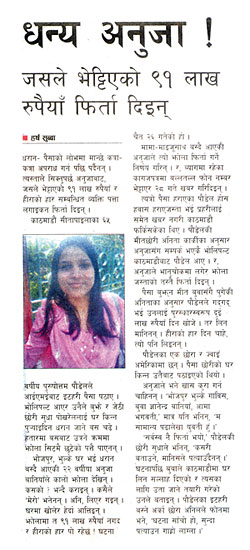 |
Exhibit A: A young lady found more than Rs 9 million and a diamond necklace in a bag in a bus while she was travelling in Dharan. She contacted and returned the money to the rightful owner. Then, she reported her noble act to a reporter of Kantipur, a national daily. Based on phone conversations with the lady and her relatives alone, the reporter and his editor gave her story a prominent play in the front page of the paper.
Exhibit B: Using the Kantipur story as a peg, the BBC Nepali Sewa interviewed the young lady. The questions were light. It did not matter if the lady seemed to fumble on some questions, the tone was triumphant: Amidst all the tales of corruption and shadiness, this heartwarming story of a seemingly innocent village woman who returned an abandoned bag with bundles of cash inside, touched a deep public chord about the innate goodness of ordinary Nepalis.
Exhibit C: The only problem was that upon further scrutiny by other members of the competitive press corps, the young woman's act of honesty turned out to be false. The media, including Kantipur and BBC Nepali Sewa, and the president who had called to congratulate the young woman, had all been fooled. Oops!
Kantipur has since issued a mea culpa, which blamed the young woman rather than its own apparent weakness in checking the authenticity of a story. BBC Nepali Sewa has moved on to other reports, while the president's office has stayed mum.
How did this reporting happen in the first place? And what does its aftermath tell us?
One-person reporting: The incident highlights a dirty little secret that's been open in the business sections of major media: that is, entire reports are often just based on press releases and a spokesperson's version of events. This practice is rife in more than one way in Nepali media.
The process of verifying assumptions, checking facts, triangulating with relevant information is not a common practice. This is partly because senior journalists are busy and do not have the time to train the young ones. It's also because there is a shortage of editors who can provide appropriate skepticism and oversight to cool down a reporter's enthusiasm for a story. Used to writing reports based on one person's quotes, as is the norm when reporting about business, many young journalists develop a habit of reporting views as news.
Competition: Those who blame the media do not seem to appreciate that it's due to the nature of competition in the media sphere that the veracity of a piece of news published in one newspaper can be challenged by another. Mistakes happen. But in the media, competition works as a force for everyone to come clean, and this competitive process can only aid a reader's understanding of the complexity behind any news.
The young woman's story was an attempt to influence the media, and at least for a while, she fooled us all.



